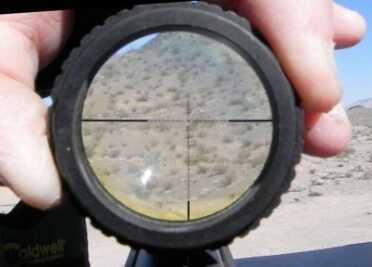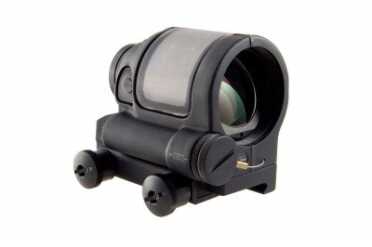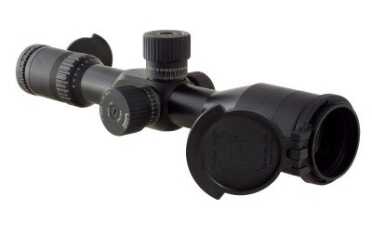Trijicon
by Scott Mayer
My first experience with any sort of red dot or reflex sight was many SHOT Shows ago when C-More sight owner, Ira Kay, explained how to use one properly. He demonstrated how keeping both eyes open when using the “heads up” screen on the C-More eliminated the perception of looking through a tube, which is exactly what you got with some of the cylindrical sights of that time. He also showed how with both eyes open, you could get the lens front covered with mud, blood or even broken, and still see the dot to aim. I was very impressed, and have owned several dot sights since. For close- to medium-range shooting where hitting the target quickly is the goal, you simply can’t beat a dot.

The reticle on Trijicon’s TARS is in the first focal plane so all range estimation or bullet drop compensation marks work equally well at all power settings.
If you haven’t tried a forward-mounted red dot sight, you really need to. So long as you keep both eyes open, the dot just seems to appear against the background in whatever focal plane you happen to be looking in at the moment. Whatever you see in focus will have the dot out there also in focus. Another beautiful thing about red dot sights is that they aren’t subject to the same parallax problems as riflescopes. If you want a good example of parallax, close one eye and aim your thumb at a distant object. Without moving your thumb, move your head from side to side. Though your thumb physically stays aimed on the distant object, it appears to move from side to side. If you correct for your head being off-center, you’ll miss because of it. With a red dot, even if your head is off center with the optic, so long as you can see the dot, wherever the dot is, is were your bullet will hit.
Many of you have probably seen red dot-type sights on AR-15 rifles, and that is a darn good application. But don’t be misled into thinking that just because you’re a deer or hog hunter that a red dot isn’t useful to you. If you still hunt, or hunt where shots are close, a red dot is really something to consider. For example, one of my favorite deer rifles is an old ’93 Mauser in 7x57mm that has a red dot mounted Scout-style about 1/4 of the way down the barrel. I use that gun exclusively for stalking whitetail in Eastern cedar thickets because any shot I get is going to be close and fast. It’s basically “jump shooting,” and I can count on that dot being wherever I look. After that, it’s just a matter of stroking the trigger to send a 154-grain roundnose on its way.

The new SRS is a red dot sight that runs primarily on solar power with a single AA battery as back up should there not be enough light.
Since the early days of red dots, both the tube-type and heads up display units have gotten a lot smaller and the new SRS that Trijicon showed at SHOT is one of the smaller ones Trijicon offers. It’s less than four inches long so when looking through it you don’t experience the tube effect. It has a really good field of view and uses a solar panel to power the illuminated dot. If there’s not enough light for solar, the SRS has a battery back-up and thankfully, it’s from a single AA battery that you can get just about anywhere instead of something exotic and expensive. Battery or solar, the power goes to an LED that projects the 1.75 MOA aiming point that has 10 brightness settings including three for night vision. Note that 1.75 MOA is a small aiming point compared to many other dot-type sights. For example, the Trijicon RMR has a dot as big as 13 MOA. So what the new SRS offers is that, in addition to target acquisition speed you get with red dot sights in general, you also get a smaller, more precise aiming point so you can more easily make a well-aimed hit at longer range.
That said, if you’re really into precision aiming, it’s worth looking at Trijicon’s new riflescope–the Tactical Advanced Riflescope (TARS). The hot thing about this American-made optic is that it has an LED-illuminated reticle with 10 settings including two for night vision and no forward emission to cause an optical signature. It’s available in either MOA or MIL variations with your choice of MOA, JW MILDot, or Duplex reticles.

The new TARS from Trijicon is a rugged, American-made tactical scope. Its reticle is in the first focal plane, and is available in either Mildot or MOA versions.
Optically, the TARS offers 3-15x variable power and a 50mm objective and its glass is “fully multi-coated.” When light hits a lens, it wants to reflect, refract and generally scatter. Coatings help the light “ease” through the glass so less of it gets lost and generally the more coatings the better. Know that as you shop for scopes, you’ll encounter ones billed as “coated,” and that usually means a cheap scope with one coating on at least one lens in its series of lenses. Next, you’ll find “fully-coated,” and that usually indicates all of the lenses in a scope have a single coating. You’ll also find “multi-coated,” meaning that at least one lens has multiple coatings. Finally, as in Trijicon’s TARS, you’ll find “fully multi-coated” meaning that all the lenses have multiple coatings. The specific coating Trijicon uses is per MIL-C-14806A and if you’re not up on that kind of terminology it means it’s a broadband anti-reflective coating. There is also a hygrophobic coating on the ocular and objective lenses so water tends to roll right off of them.
Something that might take some American shooters a little getting used to on a TARS is the reticle being in the first focal plane. Unless you’re used to using tactical scopes, it’s admittedly a little confusing at first when you crank up the magnification and see your reticle get bigger along with the target. But once you understand how to use Mildots or reticle subtensions for range estimation and bullet drop compensation, you come to appreciate the advantage of the first focal plane reticle.
When the reticle is in the second focal plane, the crosshair doesn’t change as you turn the magnification up, so as your target appears to get larger, the crosshair appears to get smaller. Many shooters like that feature as it allows for very precise aiming. The downside is when you try to integrate range estimation or bullet drop compensation into a second focal plane reticle. Because the reticle does not stay proportional to the target, range estimation or bullet drop compensation works at only one specific magnification setting. With the reticle in the first focal plane, however, it doesn’t matter what power your scope is set at because the target and reticle remain proportional. Range estimation and bullet drop compensation values remain the same at any power setting.
Windage and elevations adjustment on the MOA version of the TARS are 1/4 minute per click over a total range of 150 minutes elevation and 120 minutes windage. The comparable MIL version adjustments are in 0.1 MIL per click over a total range of 44 MIL elevation and 36 MIL windage. Physically, the TARS has a 34mm tube, weighs 47 ounces, is almost 14 inches long and 3.8 inches wide. It has a side parallax adjustment that doubles as the housing for the single CR2032 battery. Trijicon claims that because of the LED technology, the battery life is 30,000 hours–or about three and a half years.

I’m a big fan of Trijicon and own at least a dozen of their aiming devises. However, 47 ounces (approx 3 lbs.) That’s a heavy scope!
Yes, Trijicon is high priced,,, yet,,, have you priced a Leupold?? Anything close to a Trijicon is way over $1,200…. Plus, just like Leupold, Trijicon stands behind their product,,, I own many Trijicon and Leupold scopes,,, BOTH companies have repaired/replaced scopes for me, at NO cost, and returned them in a very timely manner… I will continue to buy Trijicon products,,, happy to see some new products for an American company !!
A 1.75 MOA red dot …………….. super.
Trijicon needs to scale back their prices to a more ‘earthly’ level so average people like me can afford products like these.
Please tell Ruger we need 34 mm rings for this scope!